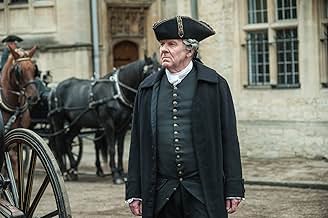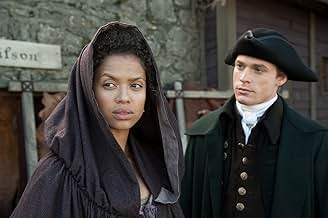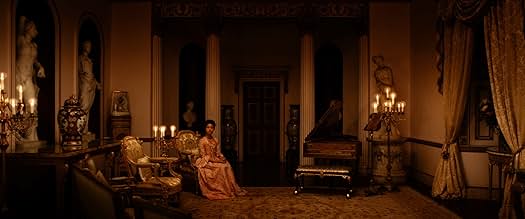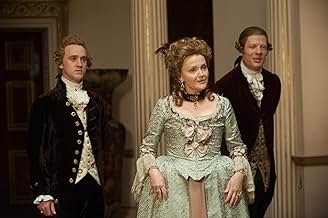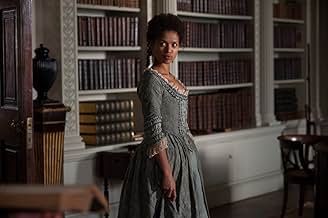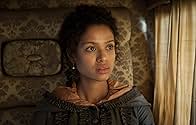Die gemischtrassige Tochter Dido Elizabeth Belle des Kapitäns der Royal Navy, Sir John Lindsay, wird vom aristokratischen Großonkel Lord William Murray, 1. Earl of Mansfield im England des 1... Alles lesenDie gemischtrassige Tochter Dido Elizabeth Belle des Kapitäns der Royal Navy, Sir John Lindsay, wird vom aristokratischen Großonkel Lord William Murray, 1. Earl of Mansfield im England des 18. Jahrhunderts, aufgezogen.Die gemischtrassige Tochter Dido Elizabeth Belle des Kapitäns der Royal Navy, Sir John Lindsay, wird vom aristokratischen Großonkel Lord William Murray, 1. Earl of Mansfield im England des 18. Jahrhunderts, aufgezogen.
- Auszeichnungen
- 13 Gewinne & 32 Nominierungen insgesamt
Empfohlene Bewertungen
This film would have been OK as a total fiction but given that it was based on a true story, I found it fascinating. Set in England in the late 1700's, it shows the impact of the slave trade on society. The patriarch of the family is a justice of the High Court of England and takes on an important case regarding a slave trading ship while confronting the reality of limitations faced by his mulatto niece. It shows that when someone becomes part of your family, and you love that person, it changes your perspective on cultural norms. This film has prompted me to look into the history of the actual legal case involved.
The film also showed the similarities between his white and mulatto nieces: as women both had a price on their heads and suffered due to their "place" in that society beneath men... This film showed that while much has changed, many attitudes have not changed in 300 years... The two brothers who court the nieces could have come from any current film if they just updated their styles of clothes, hair, and accents.
This is essentially a Jane Austen story, set a generation earlier and with a racial element thrown in. The film centres on Dido's emotional relationships. She is sought in marriage by Oliver Ashford, the younger son of an aristocratic family, but his interest is largely financial and the match is fiercely opposed by his mother and his elder brother, both of whom object to the idea of a mixed-race woman marrying into their family. The great love of her life is John Davinier, a clergyman's son, an aspiring lawyer and an ardent anti-slavery campaigner.
At her uncle's stately home Kenwood House, Dido is placed in a strange and anomalous position. By reason of her fortune she is an insider, part of England's establishment; Mansfield even worries that, because of the disparity in their financial positions she might be "marrying beneath herself" if she accepts John. Her race and her illegitimacy, however, make her an outsider. She is allowed to dine with the family when they are alone, but is forced to eat separately when they have guests who might be upset by the sight of a black face. Her position contrasts strangely with that of her cousin and close friend Lady Elizabeth Murray, another niece and ward of Lord Mansfield. Elizabeth is legitimate, but has no fortune of her own, having been virtually disowned by her father under the influence of his second wife. Yet because she is white there can be no question of Elizabeth having to dine apart from the family.
Set against the love of Dido and John is a subplot about what became known as the "Zong case". When sickness broke out on a slave ship, the captain ordered the crew to throw the slaves overboard. When the insurance company refused to compensate the ship-owners for their losses, the owners sued. Lord Mansfield was the judge who heard the case in the Court of King's Bench.
Tom Wilkinson has given a number of fine performances in recent British films (and sometimes in Hollywood too), and this is one of his best. In his dealings with Dido, whom he loves dearly, Mansfield is torn between his inner decency and the need to conform to the social proprieties of the period. In legal matters he is equally torn between the demands of the law and those of justice, which is not always the same thing. In the "Zong" case he is well aware that, in refusing to pay out on the policy the insurers are motivated by commercial considerations, not humanitarian ones; if they had any humanitarian feelings they would not have become involved in facilitating the slave trade in the first place. Nevertheless, he is equally well aware that a decision against the ship- owners will be seen as a victory for the growing anti-slavery movement and a step on the road to the abolition of the slave trade. Other good performances come from newcomer Gugu Mbatha-Raw in the leading role, Penelope Wilton as Lord Mansfield's sister and Sam Reid as John.
The film has something in common with "Amazing Grace", another film about the abolitionist movement; both tend to suggest that the fight against slavery was something waged by upper-class people in wigs sitting in elegant Georgian drawing-rooms, although "Belle" does at least put a black character at centre stage. Dido, moreover, would have known about the horrors of slavery through personal experience, whereas the likes of John Davinier and Lord Mansfield only know about them at second hand. For this reason I would have liked to see more about Dido's childhood in the West Indies before the death of her mother.
As one might expect of a British costume drama, "Belle" is visually attractive, but it is more than a mere pretty face. The "heritage cinema" genre is sometimes dismissed as a mere exercise in sentimental nostalgia, but it can be much more than that. It can also be (as in much of the work of Merchant-Ivory) a vehicle for exploring significant issues, and in this case manages to explore the questions of race, social class, compassion, justice and freedom. As Lord Mansfield put it, "Fiat justitia, ruat caelum". Let justice be done though the heavens fall. 8/10
It's based on the mesmerizing and romantic true story of the beautiful, intelligent, mixed race daughter of an admiral, who was raised in Georgian England by her aristocratic great-uncle and his wife. The script hits all the right notes as Belle struggles to find her place in a society that doesn't quite accept her, and with the help of an idealistic young vicar's son (Sam Reid-- fantastic), influences an important anti-slavery case.
Congratulations to director Amma Asante and writer Misan Sagay for bringing this story vividly to life on the screen. Gugu Mbatha-Raw was luminous as Dido Belle, and I think Tom Wilkinson gave the best role of his career. Both are Oscar-worthy performances. The film is highly recommended.
The elder women know to the nearest pound the value of potential suitors, to whom their daughters are sold off like cattle. There's an interesting subplot concerning the jettisoning of slaves by traders whose sole concern is the cash value of their cargo. An interesting subtext on which the film chooses not to elaborate is whether the fabulously wealthy heroine would identify any more with her black servant if she was just a commoner.
Wusstest du schon
- WissenswertesIn real life, Lady Elizabeth Murray married first to George Finch-Hatton, 10th Earl of Winchilsea. Their great-grandson was Denys Finch Hatton, who was played by Robert Redford in Jenseits von Afrika (1985).
- PatzerEngagement rings were not used in the late 1700s. They didn't emerge until the 1920s.
- Zitate
Dido Elizabeth Belle: My greatest misfortune would be to marry into a family who would carry me as their shame.
- VerbindungenFeatured in Belle: The Story (2014)
- SoundtracksPiano Suite in G Minor, HWV 439, Allemande
Composed by George Frideric Handel
Top-Auswahl
- How long is Belle?Powered by Alexa
Details
- Erscheinungsdatum
- Herkunftsland
- Offizielle Standorte
- Sprachen
- Auch bekannt als
- Belle
- Drehorte
- Produktionsfirmen
- Weitere beteiligte Unternehmen bei IMDbPro anzeigen
Box Office
- Budget
- 10.900.000 $ (geschätzt)
- Bruttoertrag in den USA und Kanada
- 10.726.630 $
- Eröffnungswochenende in den USA und in Kanada
- 106.578 $
- 4. Mai 2014
- Weltweiter Bruttoertrag
- 16.607.575 $
- Laufzeit1 Stunde 40 Minuten
- Farbe
- Sound-Mix
- Seitenverhältnis
- 2.35 : 1
Zu dieser Seite beitragen








